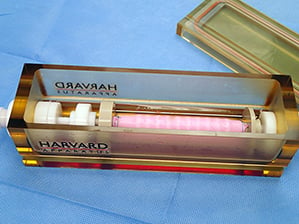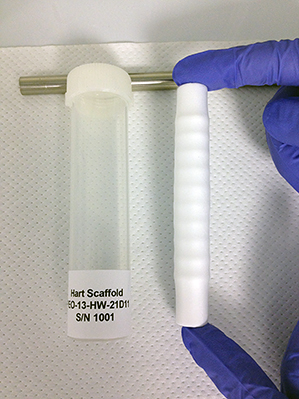Harvard Bioscience spin-off is stepping up its production of synthetic tracheas to supply clinical trials.
Why It Matters
A shortage of donor organs means that people die every day waiting for transplants.

Breathe in: A lab-grown trachea sits in a rotating incubator, ready for transplantation into a toddler.
Since 2008, eight patients have been given a new chance at life when surgeons replaced their badly damaged tracheas with man-made versions. This highly experimental technology is now moving from research labs to a manufacturing facility as a Boston-area company prepares to produce the scaffolds for growing the synthetic organs on a large scale.
Harvard Apparatus Regenerative Technology, or HART, is testing its synthetic trachea system in Russia and has plans for similar tests in the European Union this year. The company is working with the U.S. Food and Drug Administration to set up a trial in the United States as well.
The synthetic windpipes are made by growing a patient’s own stem cells on a lab-made scaffold. In the future, this technique could be adapted to create other organs, such as a replacement esophagus, heart valve, or kidney.
If expanded into more body parts, the synthetic organ technology could help meet a dire medical need. Transplant waiting lists for vital organs such as hearts, lungs, livers, and kidneys are distressingly long. Every day, patients die waiting for donor organs. In the U.S. alone, 120,000 people are on waiting lists for an organ, estimates the U.S. Department of Health and Human Services. And waiting lists underestimate the true need, says Joseph Vacanti, a surgeon-scientist at Massachusetts General Hospital and a leader in tissue-engineering research. “The only way we are going to meet that real need is to manufacture living organs,” says Vacanti, who is not affiliated with HART.

Breathe out: A synthetic trachea scaffold made by spinning extremely fine fibers of plastic into a tube.
Researchers around the globe are finding new ways to create tissues for transplantation. “Over 25 years, the field has gone from fiction and fantasy to science and engineering,” says Vacanti. There are many different approaches, from precise ink-jet printing of cell types into an organized structure (see “Printed Eye Cells Could Help Treat Blindness”) to letting cells spontaneously self-organize into proto-organs (see “A Rudimentary Liver Is Grown from Stem Cells” and “Growing Eyeballs”).
HART’s current approach is to grow a patient’s stem cells on synthetic scaffolds. The four most recent artificial trachea surgeries have been done with these lab-made scaffolds, says David Green, CEO of HART.
Growing a patient’s own cells on a scaffold provides a good environment for bone marrow stem cells that can then develop into various cell types both in the incubator and after they are implanted into a patient.
HART creates the scaffolds by spinning fibers about a hundredth of the width of a human hair into a tube that is made to fit each patient. The result is a customized scaffold “that makes a mesh that’s the right size for the cells,” says Green. “They feel at home there.”
Stem cells taken from a patient’s bone marrow are then “rained down over the top of the scaffold, much like a chicken in a rotisserie,” says Green. The cells grow on the scaffolds in a specialized rotating incubator for about two days before they are transplanted. About five days after the transplant, new cell types appear on the organ, he says, including important cells that line the inner surface and help move mucous from the lungs by coughing. Eventually, blood vessels grow into the synthetic organ, says Green.
Nenhum comentário:
Postar um comentário
Observação: somente um membro deste blog pode postar um comentário.